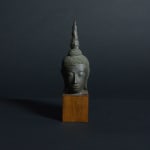Ayutthaya Bronze Head of the Buddha, 16th Century CE - 18th Century CE
Bronze
height 21 cm
height 8 1/4 in
height 8 1/4 in
FZ.346
Further images
The establishment of the new kingdom of Ayutthaya in the middle of the 14th century and the change of the political center of Thai power from Sukhothai to Ayutthaya marked...
The establishment of the new kingdom of Ayutthaya in the middle of the 14th century and the change of the political center of Thai power from Sukhothai to Ayutthaya marked the beginning of a new era of great cultural prosperity. From the capital city of Ayutthaya located at the confluence of three rivers (the Chao Phraya, the Pasak, and the Lopburi) the kingdom of Ayutthaya dominated Menam Basin for over four centuries. However, it is clear that this strategic geographical and economical site had been settled by an ancient community, long before King Ramathihodi I traditionally founded the city. Ramathihodi I was a renowned warrior and lawmaker. Under his leadership, and under his immediate successors, the kingdom rapidly expanded north towards Sukhothai and east towards the Khmer capital of Angkor Wat, which they managed to seize for a brief interval. Under royal patronage, Buddhism flourished and Ayutthaya became an important Buddhist center. The rulers of this dynasty, like the rulers of the Sukhothai Kingdom, patronized cultural and religious intercourse between Sri Lanka and Thailand and encouraged and supported the development and propagation of Sihala Buddhism in Thailand. Centuries of battles with the Burmese would eventually culminate in the sacking and burning of Ayutthaya in 1767, thus ending one of the most prosperous and culturally influential periods in Thai history.
A magnificent display of artistic and philosophical workmanship, this Buddha head mounted on a wooden block radiates with the serenity and peacefulness experienced in the state of Nirvana. Liberated from the cycle of individual existence, the figure enters a stage of transcendental existence, neither knowing or being known, it becomes enlightened. The profound meaning of simplicity and delicacy are demonstrated through the soft, subtle curvature of the face and the space of emptiness in its meditative expression. Elongated earlobes, stucco coiffure, and the shaft of fire emanating from the topknot of the head signify the stylistic character of images from Theravada Buddhism.
This piece is not just a figure to be admired for its religious quality, but it is truly an example of how religious practices fuel the human invention of art. It is a masterpiece of timeless beauty and remains to be object of awe and veneration.
A magnificent display of artistic and philosophical workmanship, this Buddha head mounted on a wooden block radiates with the serenity and peacefulness experienced in the state of Nirvana. Liberated from the cycle of individual existence, the figure enters a stage of transcendental existence, neither knowing or being known, it becomes enlightened. The profound meaning of simplicity and delicacy are demonstrated through the soft, subtle curvature of the face and the space of emptiness in its meditative expression. Elongated earlobes, stucco coiffure, and the shaft of fire emanating from the topknot of the head signify the stylistic character of images from Theravada Buddhism.
This piece is not just a figure to be admired for its religious quality, but it is truly an example of how religious practices fuel the human invention of art. It is a masterpiece of timeless beauty and remains to be object of awe and veneration.







